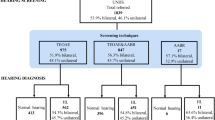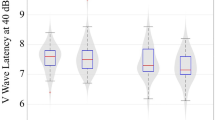Abstract
OBJECTIVE: The purpose of the study was to assess the feasibility of performing universal newborn hearing screening in different clinical settings and tracking the infants who did not pass initial screening through their confirmatory testing.
STUDY DESIGN: Between December 1996 and December 1997, a total of 11,711 infants were enrolled from five clinically different study sites. Universal newborn hearing screening was performed using automated auditory brainstem response (AABR) testing. Infants who did not pass the initial screening were tested again prior to discharge. Data regarding the rate of referral for follow-up testing, age of infant at screening, the duration of time required for screening, and type of personnel performing the test were collected. Formal audiology appointments were made prior to discharge for infants who required follow-up testing, and letters were sent with phone calls made to those who failed to keep their appointments for repeat testing. Outpatient testing consisted of a repeat AABR and, if necessary, a diagnostic auditory brainstem-evoked response, otoacoustic emission testing, and tympanometry.
RESULTS: At the time of hospital discharge, the refer rate was <2% (215 of 11,711 newborns) using AABR screening. Sensorineural hearing loss (SNHL) was confirmed in 32 of these infants, resulting in an overall incidence of confirmed SNHL of 2.7 per thousand newborns. The false-positive rate ranged from 0.3% to 2.5%, with a cumulative false-positive rate of 0.9% (1.5% if all infants lost to follow-up are included as false-positives). No false-negatives were identified. The average time of testing was 7.1 minutes independent of the personnel performing the testing and the age of testing was <24 hours in 70% of the infants tested. The total number of infants lost to follow-up was 61 (29% of patients referred or 0.5% of the study population).
CONCLUSION: This study demonstrated that the refer rate for universal hearing screening with the AABR was acceptably low when performed by a variety of personnel in typical nursery settings within the first 24 hours after birth. A low rate of screening failures with the AABR minimizes costs associated with subsequent follow-up assessments and lessens any potential impact of false-positive screening on the parent–newborn relationship.
This is a preview of subscription content, access via your institution
Access options
Subscribe to this journal
Receive 12 print issues and online access
$259.00 per year
only $21.58 per issue
Buy this article
- Purchase on Springer Link
- Instant access to full article PDF
Prices may be subject to local taxes which are calculated during checkout
Similar content being viewed by others
Author information
Authors and Affiliations
Rights and permissions
About this article
Cite this article
Stewart, D., Mehl, A., Hall, J. et al. Universal Newborn Hearing Screening With Automated Auditory Brainstem Response: A Multisite Investigation. J Perinatol 20 (Suppl 1), S128–S131 (2000). https://doi.org/10.1038/sj.jp.7200449
Published:
Issue Date:
DOI: https://doi.org/10.1038/sj.jp.7200449
This article is cited by
-
Protocol and programme factors associated with referral and loss to follow-up from newborn hearing screening: a systematic review
BMC Pediatrics (2022)
-
Neonatal hearing screening of high-risk infants using automated auditory brainstem response: a retrospective analysis of referral rates
Irish Journal of Medical Science (1971 -) (2014)



